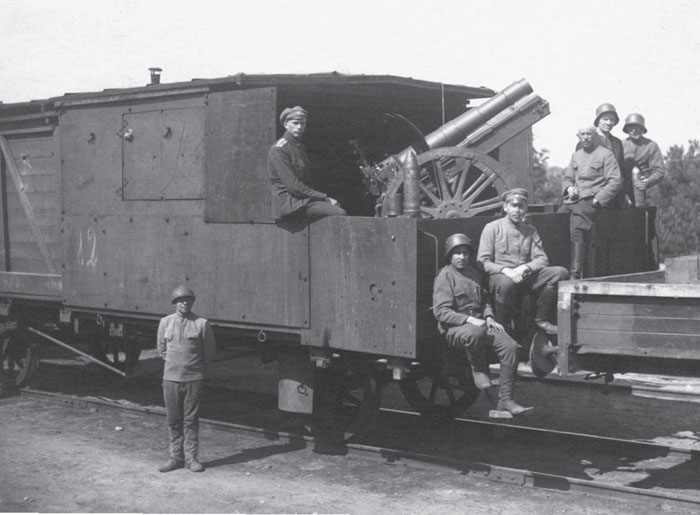
Estonia declared its independence from Russia on 24 February 1918, but the capital Tallinn was occupied by German troops the following day. The Estonians had to wait for the Armistice of 11 November to gain their autonomy, and began to build up their own armed forces five days later. Profiting from the chaotic situation at the end of the Great War, on 28 November the Red Army attacked a German unit and troops of the Estonian National Guard, and the War of Independence began. In some areas the armoured trains were the most powerful armament available to the Estonians. The standard gauge was widespread apart from the narrow-gauge network which connected the southern part of Estonia with the northern part of Latvia.
The very first Estonian armoured train was in fact German, found abandoned at Tallinn in November 1918. It was made up of two artillery wagons (76mm guns) and two infantry wagons, with improvised protection which the Estonians upgraded. This train, allocated the number 1, arrived at the front on 30 November. It was made up of the following units: artillery wagon + two infantry wagons (one protected by sandbags, the other with iron plates) + unarmoured engine2 + the same units in reverse order. The crew was composed of 120 troops, made up of artillerymen, machine-gunners, and a strong infantry assault contingent.
The next five trains (on the standard gauge) went into action in the following order: on 15 and 23 December 1918, and then 21 January, 19 March and 12 August 1919. Armoured Trains Nos 5 and 6 included modern wagons (one artillery wagon + three machine-gun wagons + five infantry wagons). In August 1919, an Armoured Trains Division was created, which formed the strategic reserve of the Commander-in-Chief. By the end of 1919, the Armoured Trains force had fifty-five standard gauge wagons, and each of the artillery wagons was individually named.
Five armoured trains were built to operate on the narrow-gauge network. These were delivered on 1 January (SR No 1), 18 to 26 January, 21 February, 1 May (replacement SR No 43), and 2 July 1919 respectively. Several narrow-gauge trains were protected by trench shields, which gave them a distinctive appearance. In general these trains were made up of two artillery wagons, one or two machine-gun wagons and three or four infantry wagons. They carried a lighter armament than the standard-gauge units, with 47mm and 57mm guns, but included several 76.2mm Russian field guns.
After the Russian forces had been repulsed, the Estonians concentrated their military efforts against the Landeswehr who were attempting to maintain German influence throughout the Baltic States. Peace with Russia was signed on 31 December 1919. By the ceasefire date, the Estonian armoured trains numbered eleven: six armoured trains on the standard gauge (numbered from 1 to 6, the first bearing the name Kapten Irv4), and five trains for the narrow gauge (numbered 1 to 5). Between them these eleven trains carried twenty-seven artillery pieces and 118 heavy machine guns.
On 1 February 1921, several trains were demobilised and the Division was reformed as a Brigade, with the following units: (standard gauge) SR Kapten Irv, SR No 2 and SR No 3, (narrow gauge) SR No 1 and SR No 2. In total the Brigade had three armoured engines, twelve artillery wagons, sixteen machine-gun wagons and twelve infantry wagons. In 1922, the narrow gauge SRs were demobilised and stored in depots, and then finally disbanded during the 1930s (certain units would resurface in modernised form in 1941 to face the Wehrmacht).
In addition to the formed armoured trains, there were certain individual wagons which could be attached to or detached from any existing train as need be. As these wagons each carried their own name, it is often difficult to identify a specific train solely from the name of the wagon seen in a photo.
On 1 February 1923, the Brigade was reorganised into two Regiments each comprised of two trains, then in December 1934 these two Regiments were merged into the Armoured Trains Regiment, comprising trains Kapten Irv, SR No 2 and SR No 3, the long-range railway gun battery, two engineer companies and two machine-gun companies. In 1936 the railway gun battery comprised one gun truck (‘Suur Tõll’) armed with a 152mm Canet gun, and two (‘Müristaja’ and ‘Tapper’) each armed with a 4in (102mm) gun. The plan was to combine the armoured trains with the railway gun but the financial situation of the country slowed down progress, to the point where, when the Soviets invaded Estonia on 17 June 1940, three gun trucks were still under construction, a part of the armament of the trains had been dismounted, and the acquisition of certain wagons had been put on hold.
The former Estonian Army became a corps of the Red Army and on 12 February 1941, the armoured trains were attached to the Baltic Sea Military District. Although their ultimate fate is unknown, it appears that several wagons were sent to the front around Leningrad. At the start of Operation ‘Barbarossa’, the Russian High Command ordered the construction of new armoured trains at Tallinn where the rail workshops had the necessary experience. Two narrow-gauge trains5 and a standard-gauge railway gun battery were built, and these units took part in the defence of Tallinn up until it fell on 28 August 1941.
Despite details given in the following sources, it is extremely difficult to identify a particular train from the names painted on the wagons, given the transfers between trains and successive modernisation schemes. The photo captions which follow are therefore indicative only.

One of the wagons of the train captured from the Landeswehr. Note the assorted headgear: Russian caps, German Stalhelm and French Adrian helmets.
(Photo: Paul Malmassari Collection)
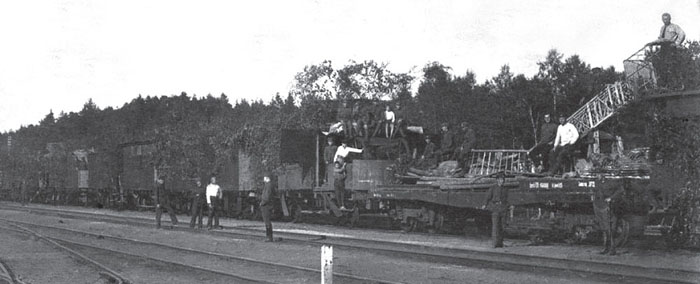
A telescopic observation platform extending up to 25m (82ft) high could be attached to an armoured train. Here the unit is shown lowered in the travelling position. The elements of the trains are heavily camouflaged with branches.
(Photo: Paul Malmassari Collection)
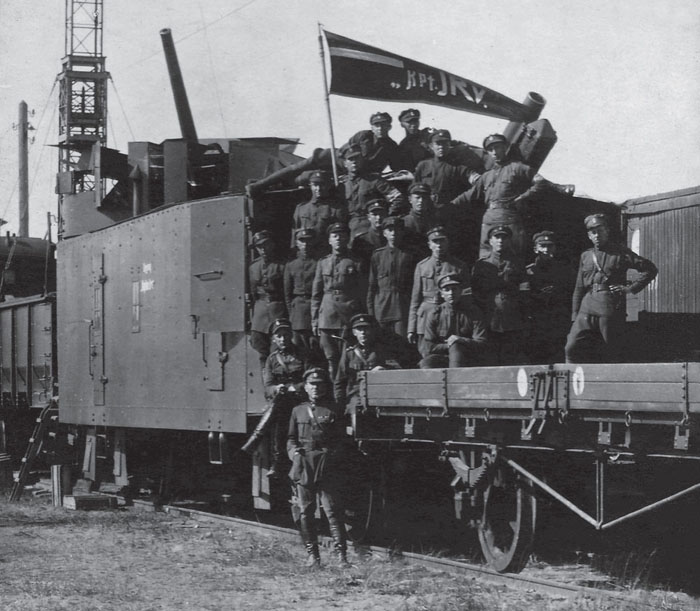
The pennant of SR Kapten Irv on an unidentified wagon, probably part of SR No 5. In the left background is the telescopic observation tower in the raised position.
(Photo: Paul Malmassari Collection)
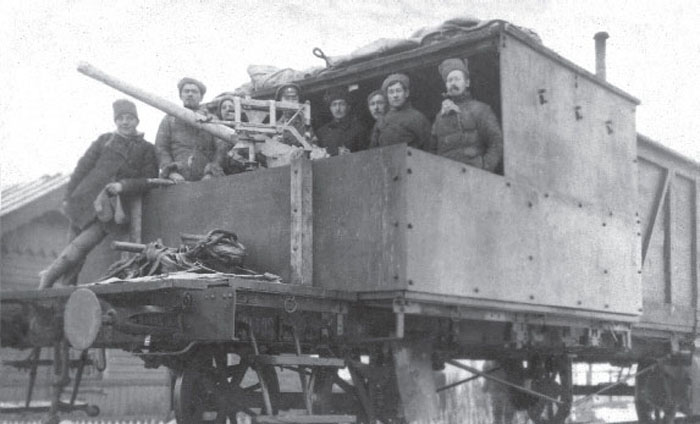
‘Tommi’, the leading wagon of Kapten Irv, showing its 6pdr (57mm) gun.
(Photo: Paul Malmassari Collection)
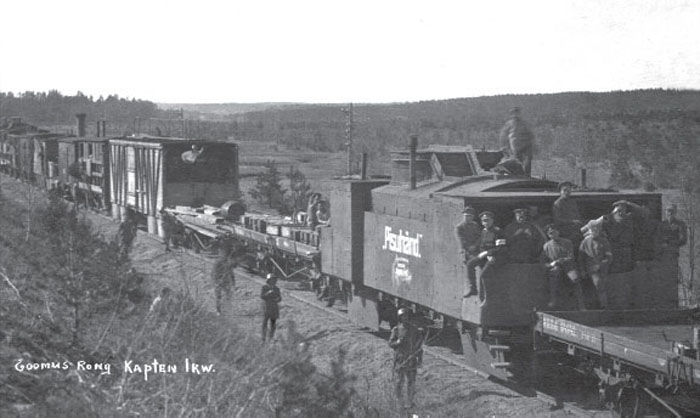
The wagon ‘Pisuhänd’ of SR No 1 Kapten Irv. This photo shows the later configuration of the wagon fitted with a gun cupola.
(Photo: Paul Malmassari Collection)
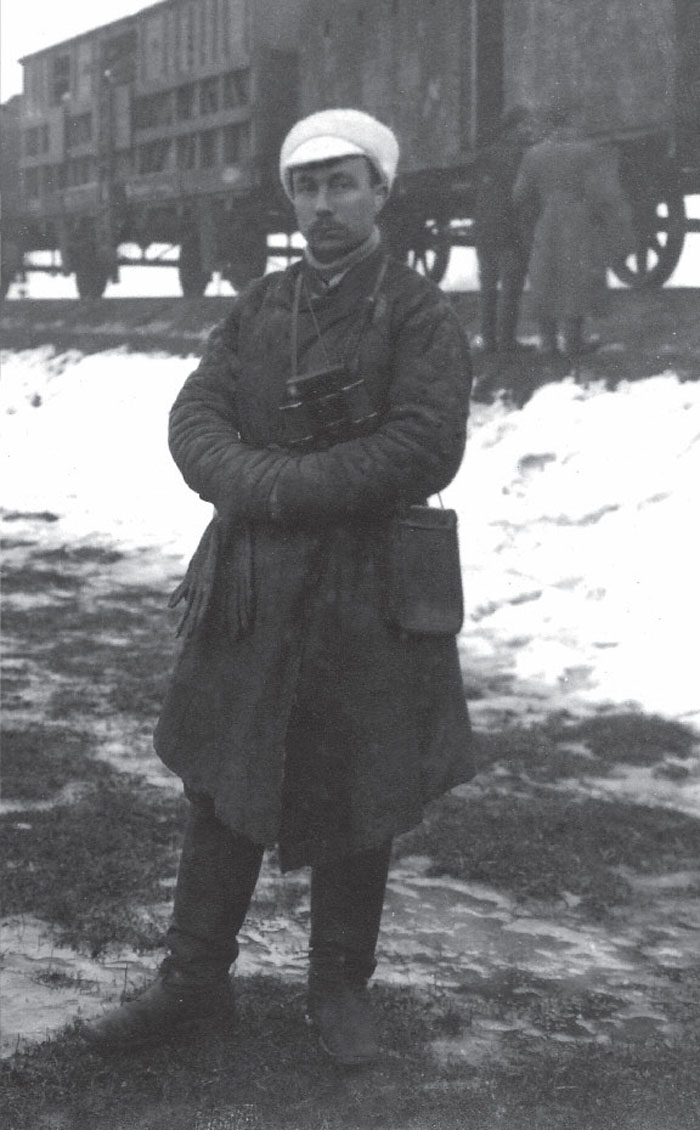
Captain Irv, who gave his name to the armoured train he commanded.
(Photo: Paul Malmassari Collection)
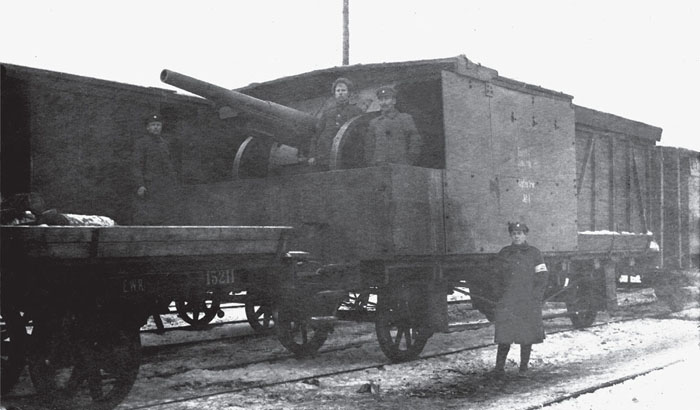
An artillery wagon forming part of SR No 1. An armoured box encloses one end of a long-wheelbase outside-framed wooden wagon. The vulnerable axle boxes are protected by simple rectangular plates.
(Photo: Paul Malmassari Collection)
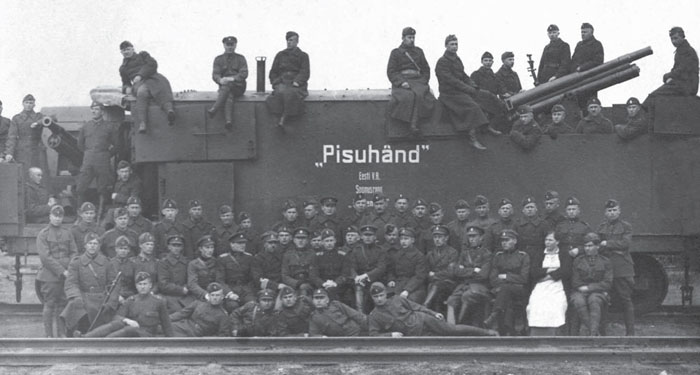
This view of ‘Pisuhänd’ appears to show its final configuration circa 1939.
(Photo: Paul Malmassari Collection)
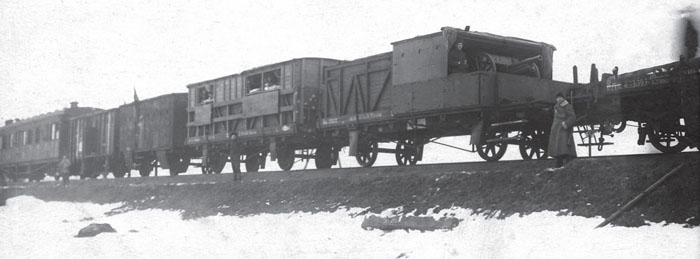
Kapten Irv in original condition.
(Photo: Paul Malmassari Collection)
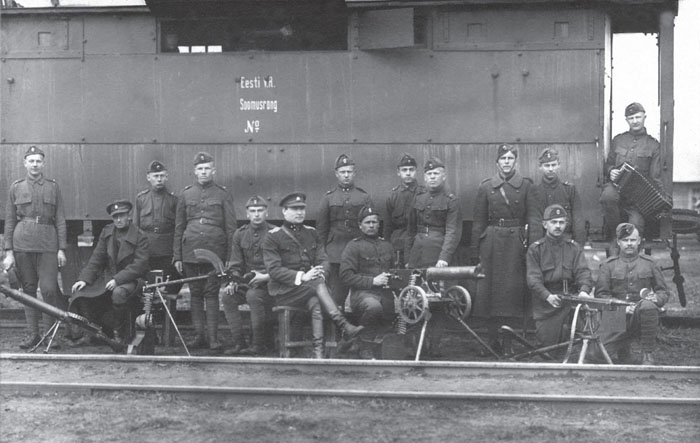
SR No 2 in 1919. Note the assorted collection of machine guns: From left to right, a Lewis, a Madsen (Russian calibre), a Russian Maxim on a wheeled carriage, and a Colt Browning ‘Potato Digger’. A second Maxim is mounted inside the wagon. Note also the accordion held by the crewman on the right.
(Photo: Paul Malmassari Collection)
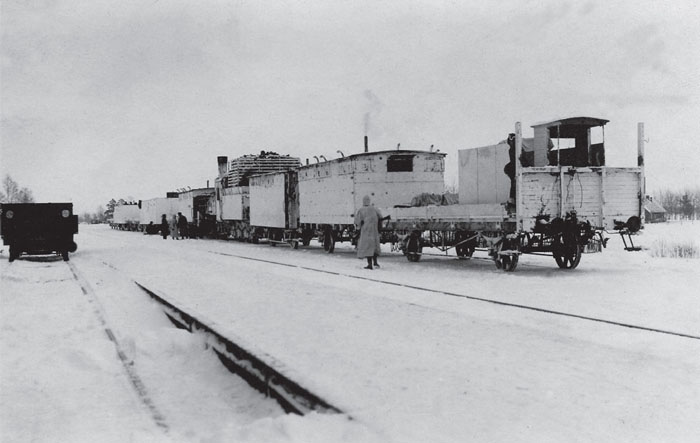
SR No 2 in winter camouflage. Note the smoke from the heating stove in the second wagon.
(Photo: Paul Malmassari Collection)
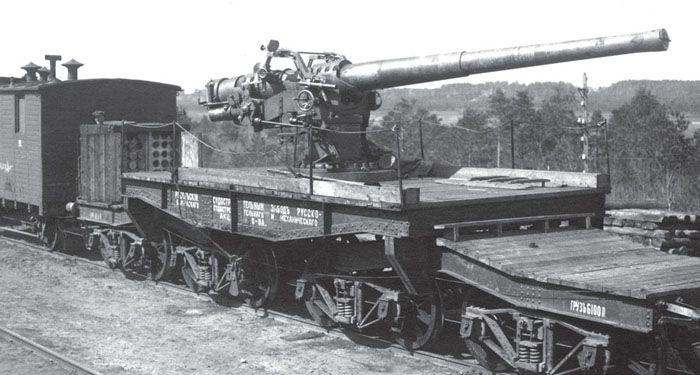
Vickers 130mm railway gun ‘Kalewipoeg’ attached to SR No 2.
(Photo: Paul Malmassari Collection)
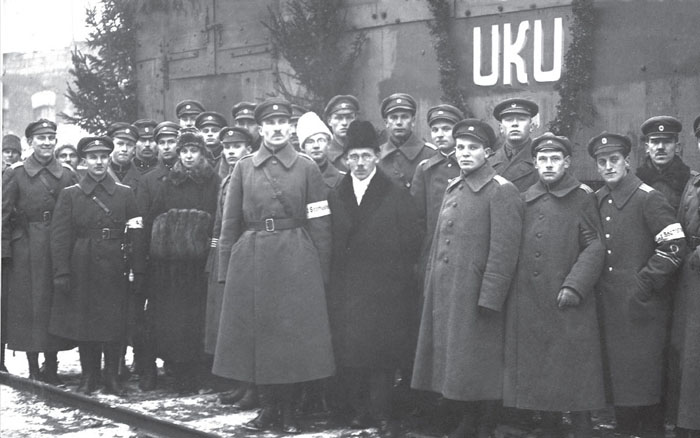
The crew of SR No 2 in front of artillery wagon ‘Uku’, built on the chassis of a Russian wagon, probably in 1919. Their armband bearing the number of the train is a feature which appears in many photos. In addition to the fir trees attached as camouflage, ‘Uku’ carries a wreath for an official ceremony attended by August Rei (the civilian in the centre), Chairman of the Constituent Assembly 1919–20, and his wife. Note the letters ‘Uku’ painted in shadow to give the impression of relief.
(Photo: Paul Malmassari Collection)
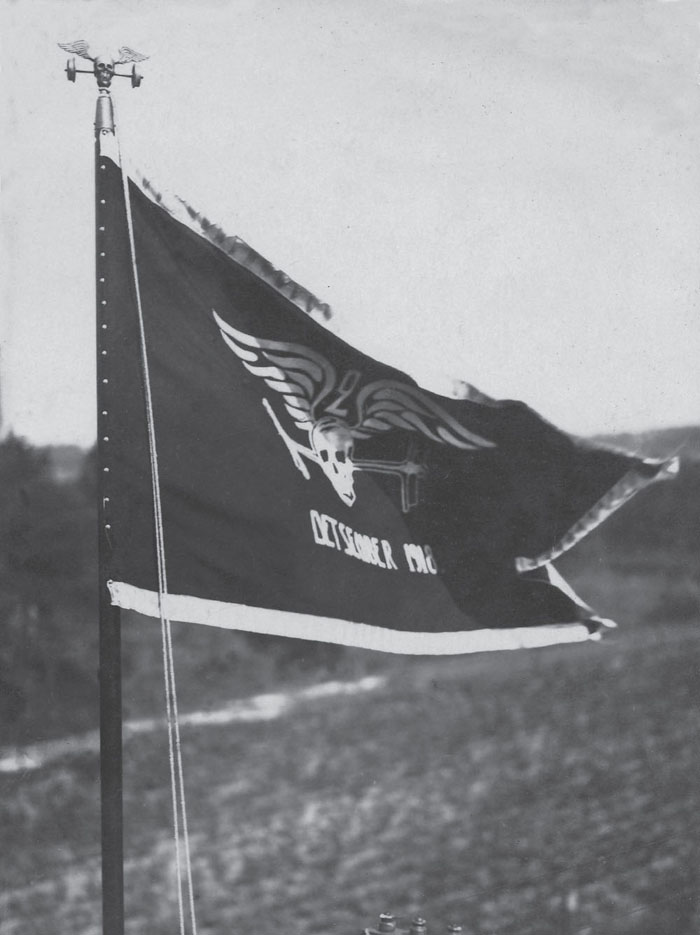
One of several postcards dedicated to SR No 2, this one bearing the armoured train’s pennant.
(Postcard: Paul Malmassari Collection)
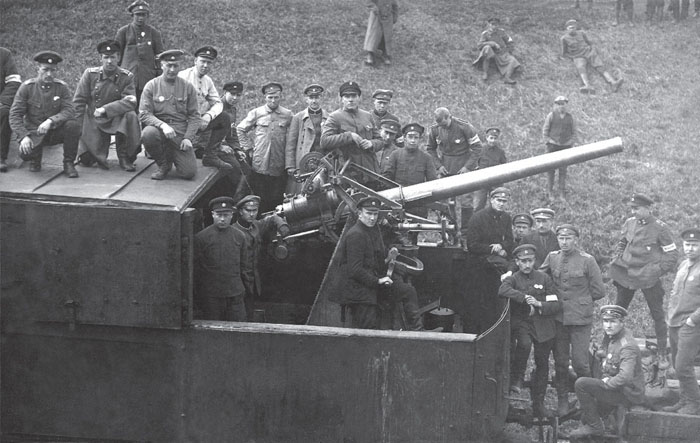
75mm gun on wagon ‘Onu Tom’ of SR No 3. The gun appears to be a British naval 3in HA, for anti-aircraft use. Later, this wagon would be rearmed with Vickers 152mm howitzers.
(Photo: Paul Malmassari Collection)
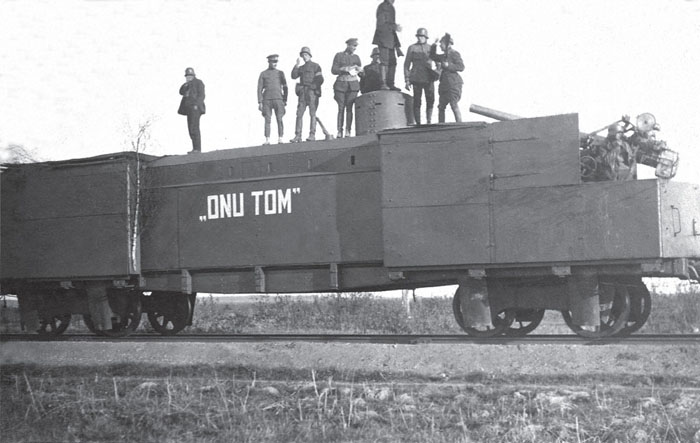
A view of ‘Onu Tom’ of SR No 3, on 15 April 1919, showing the naval 3-inch HA gun. It was also armed with a 76.2mm Russian field gun at the opposite end.
(Photo: Paul Malmassari Collection)
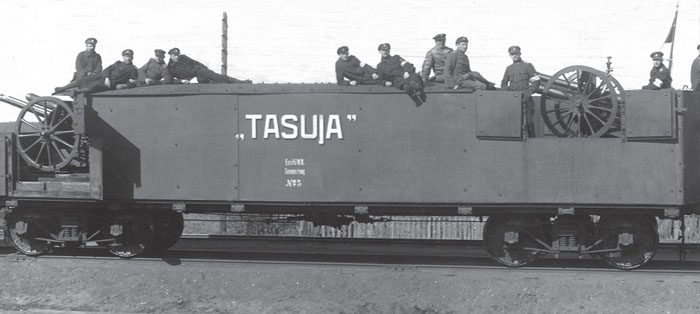
Wagon ‘Tasuja’ of SR No 5, armed with British 18pdr (84mm) and 13pdr (76mm) field guns.
(Photo: Paul Malmassari Collection)
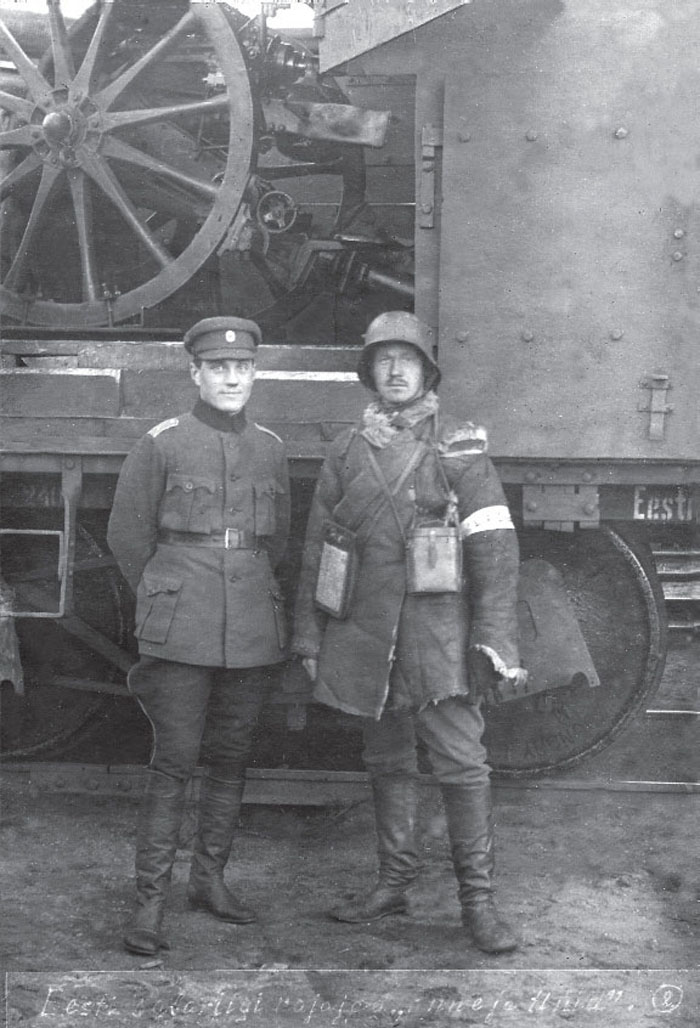
A view of the end of ‘Tasuja’ carrying the 18pdr in the lower position. Note that the wheels of the field gun are bolted to a plate on which it revolves.
(Photo: Paul Malmassari Collection)
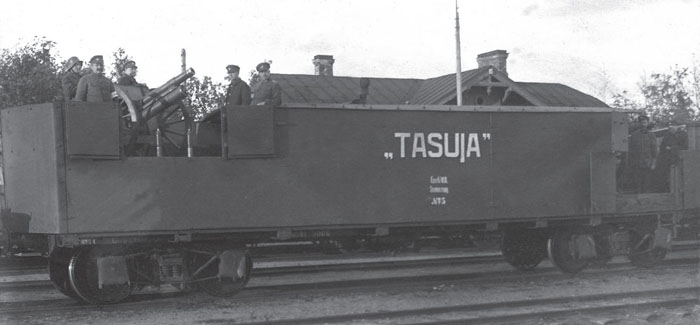
A view of ‘Tasuja’ rearmed with a Russian 76.2mm field gun.
(Photo: Paul Malmassari Collection)
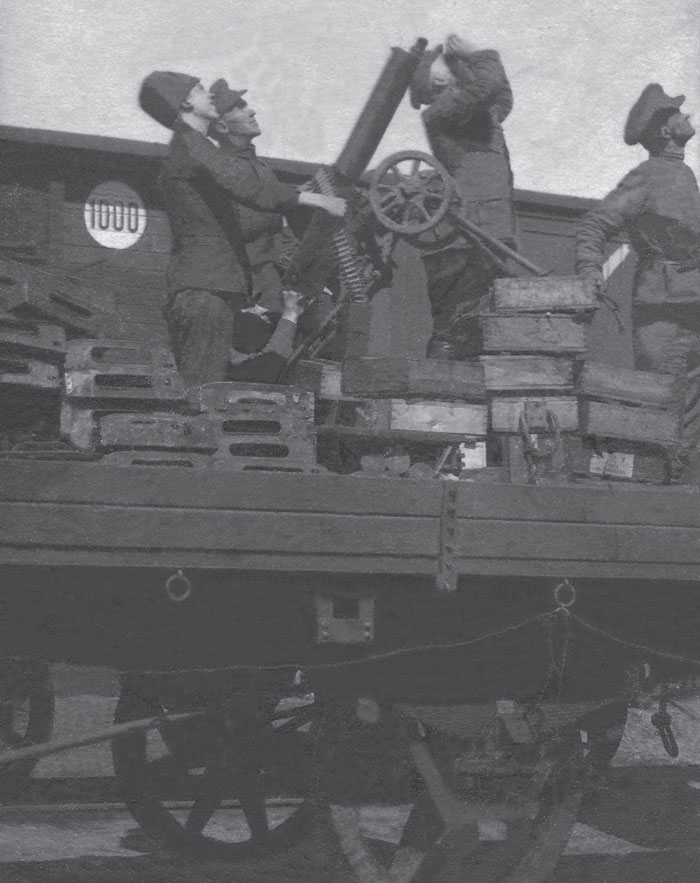
Close-in anti-aircraft defence of the armoured trains was provided by Russian Maxim heavy machine guns, here seen on SR No 5 with a five-man crew. The mount has been given the necessary elevation by the simple expedient of propping the front legs of the tripod on a pile of empty cartridge boxes, stacked on a two-plank wagon. This improvised solution would give only limited traverse to avoid the mount toppling over on its side. The planking and roof in the background belong to a goods wagon on the neighbouring track.
(Photo: Paul Malmassari Collection)
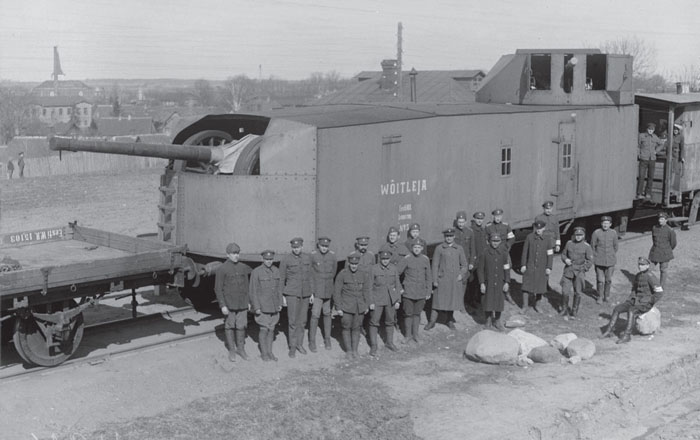
‘Woitleja’ in October1919, equipped with what may be a Canet 120mm Pattern 1892 gun in its end casemate. Note that the field piece has retained its wheeled mounting, which severely limited its horizontal field of fire.
(Photo: Tiit Noormets Collection)
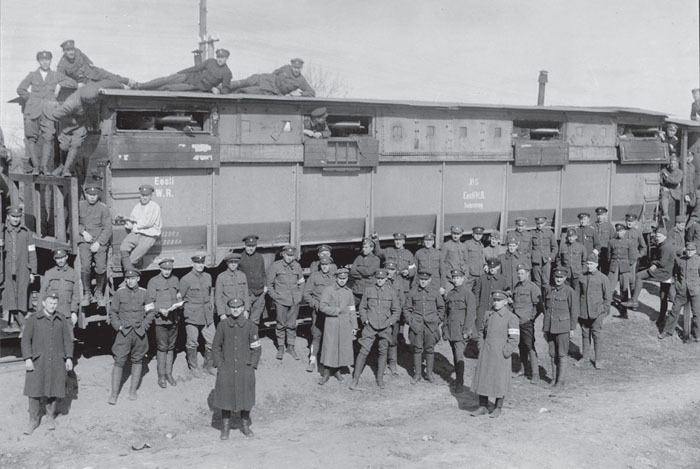
An interesting photo of SR No 5, showing a Russian bogie wagon with the armour increased in height and pierced for four firing positions for machine guns and lookout hatches. This type of wagon would not be kept in service once the fighting had ended.
(Photo: Tiit Noormets Collection)
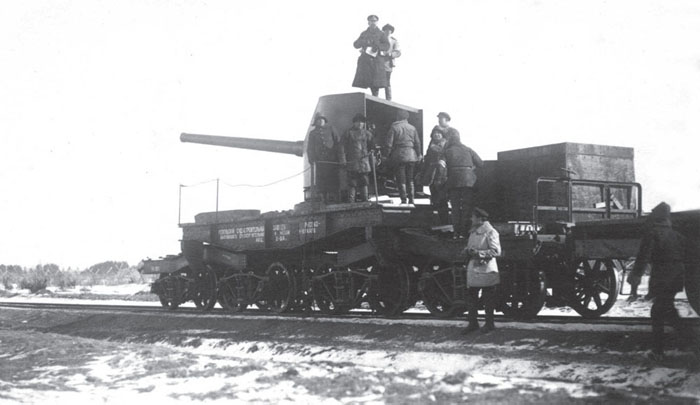
6in (152mm) railway gun ‘Lembit’, attached to SR No 5.
(Photo: Paul Malmassari Collection)
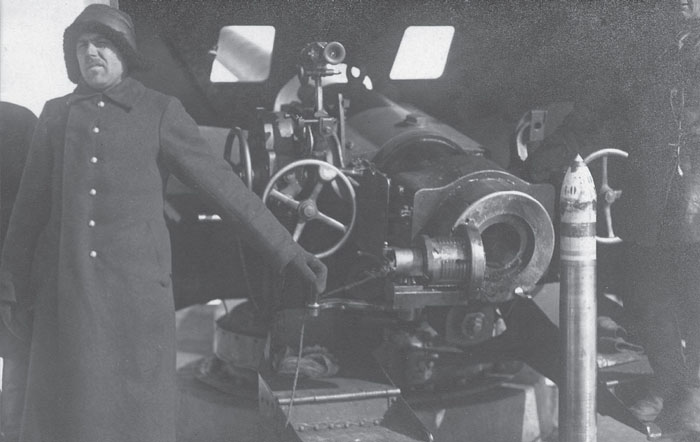
Closeup of the ‘Lembit’ gun. The combination of fixed round and screw breech indicate this is a Russian Canet 6in/45 built to a French design. Similar guns can still be seen on board the museum ship Aurora.
(Photo: Paul Malmassari Collection)
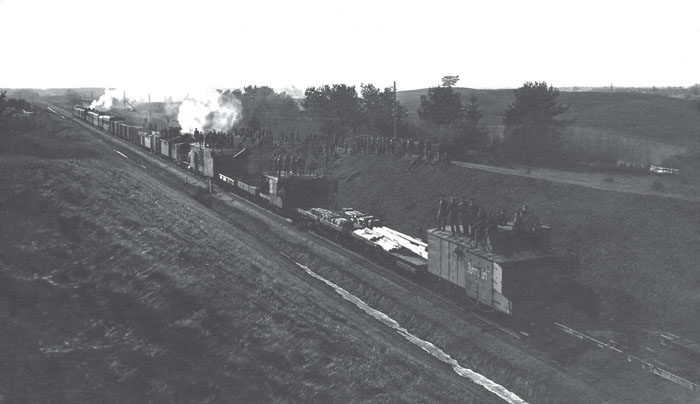
SR No 6 in action in 1919. The artillery wagon in the foreground is ‘Rummu Jüri’, armed with a Russian 76.2mm field gun. The artillery wagon with the long gun is ‘Leitnant Sabolotnõi’.
(Photo: Paul Malmassari Collection)
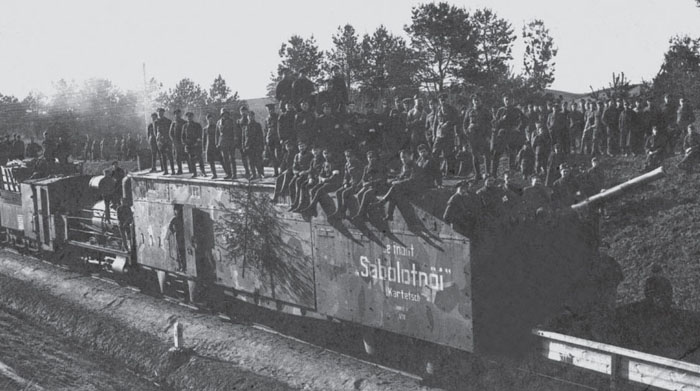
An overall view of the latter artillery wagon with its long-barrelled 4.7in (120mm) British gun. Several crew members wear armbands specific to the train. The wagon carries camouflage paint panels in addition to the standard pine tree.
(Photo: Paul Malmassari Collection)
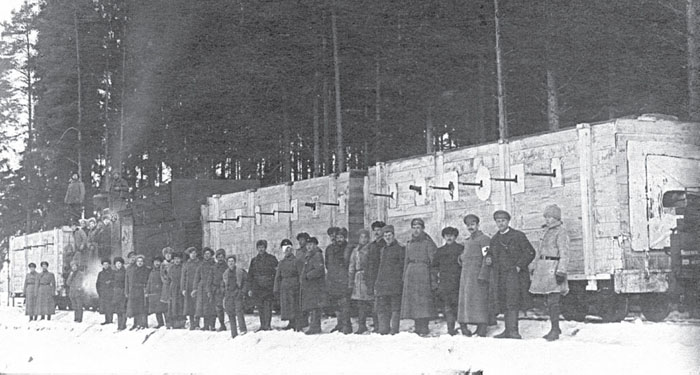
SR No 1 (narrow gauge) in January 1919. Each infantry wagon appears to be equipped with one Lewis Gun. Note the medical orderly, and the wounded crew member in the centre of the group.
(Photo: Paul Malmassari Collection)
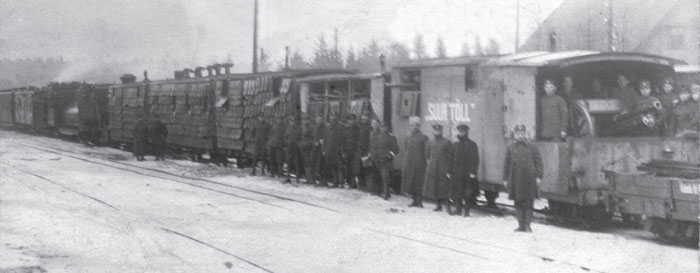
Artillery wagon ‘Suur Tõll’ armed with a Russian 76.2mm field gun, part of SR No 2.
(Photo: Paul Malmassari Collection)
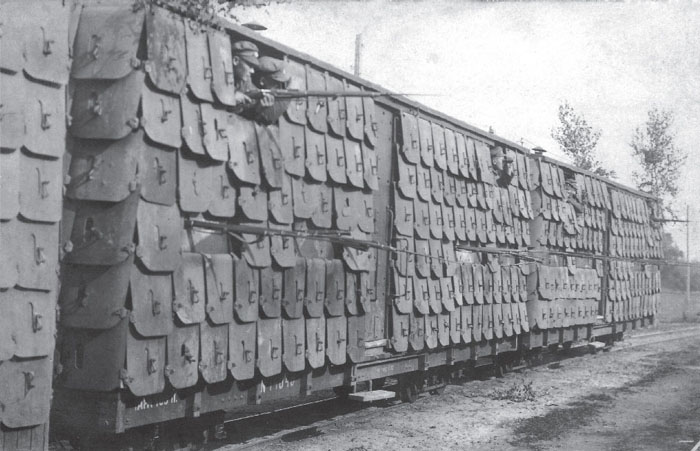
A closeup of the type of armour protection used on some narrow-gauge infantry wagons, comprising Russian trench shields. This type of wagon formed part of Armoured Trains Nos 2, 4 and 5. Note the riflemen have fixed bayonets. At first sight this seems incongruous, as they are fighting from behind armour and would not expect to use bayonets in close combat. But the Mosin-Nagant was never issued with a bayonet scabbard, so the bayonet is usually seen fixed.
(Photo: Paul Malmassari Collection)
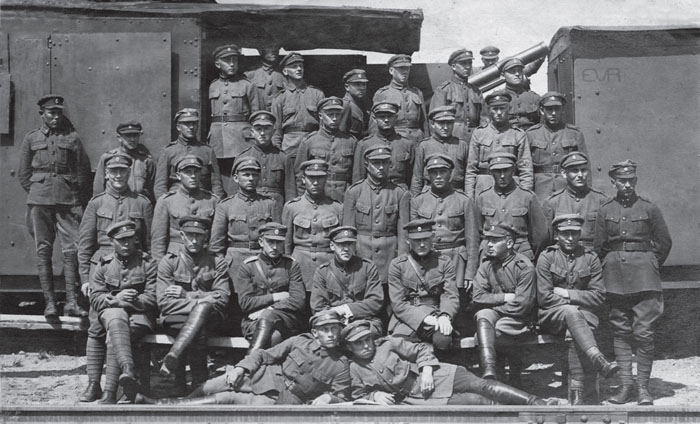
The crew of SR (narrow gauge) No 4 in front of the artillery wagon armed with a 76.2mm Russian field gun.
(Photo: Paul Malmassari Collection)
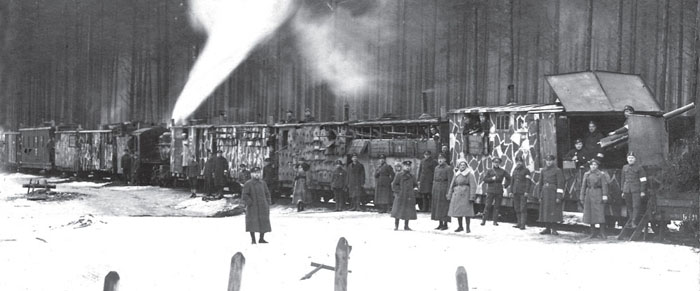
An overall view of SR (narrow gauge) No 5.
(Photo: Paul Malmassari Collection)
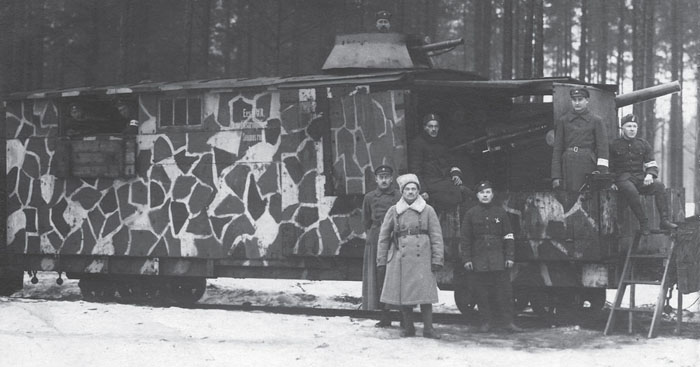
SR (narrow gauge) No 5 wearing camouflage.
(Photo: Paul Malmassari Collection)
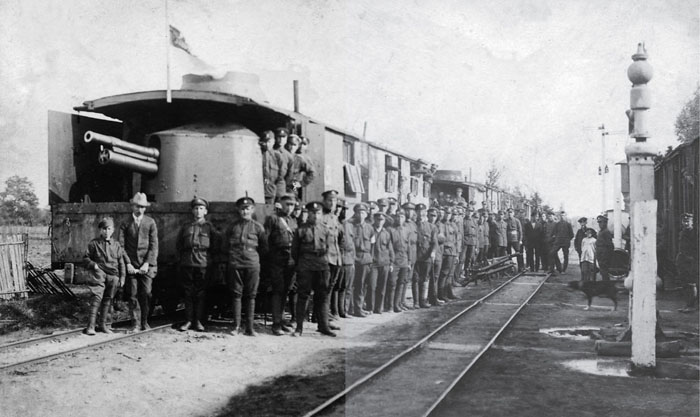
SR (narrow gauge) No 5 showing one of its 76.2mm Russian field guns.
(Photo: Paul Malmassari Collection)
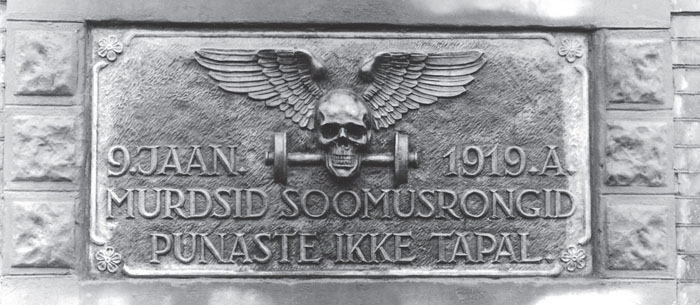
A bronze plaque on the wall of the station at Tapa, mounted on 9 June 1934 (restored to its position on 20 February 1993), bearing the insignia of the Armoured Trains Regiment.
(Photo: Paul Malmassari Collection)
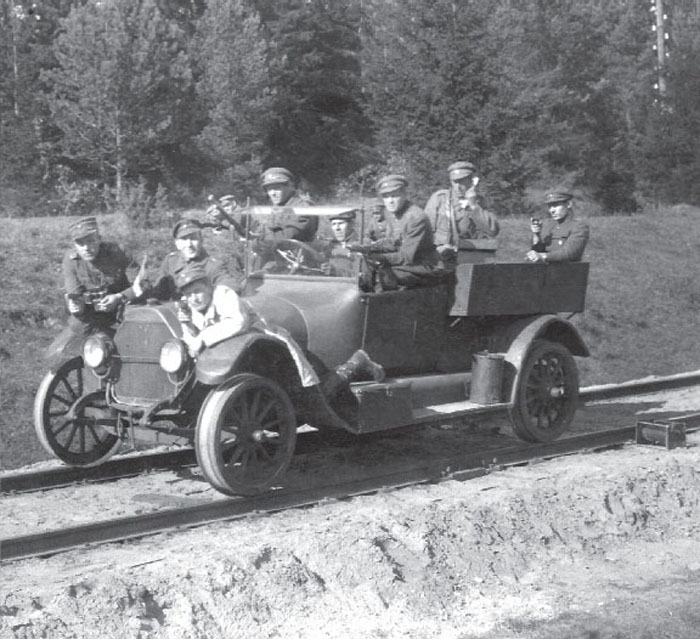
Trolley No 145 of the 2nd Armoured Trains Regiment, used for the high-speed liaison role away from combat zones. The crew are lightly armed, with one rifle and pistols, probably Brownings. One occupant in the rear seat is talking on a field telephone, the cable reel for which is on the ground beside the track.
(Photo: Paul Malmassari Collection)
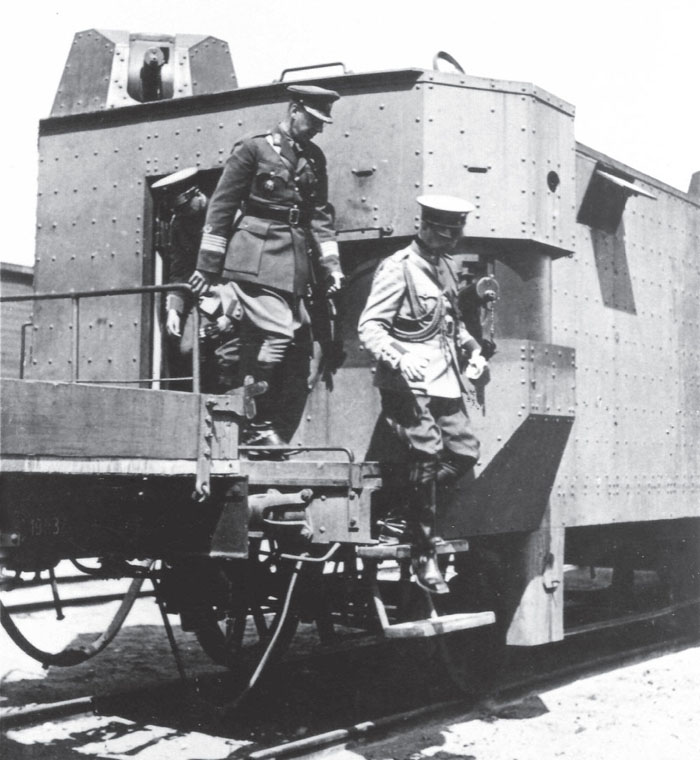
Armoured wagon No 212 in 1930. The two ends are symmetrical, with the machinegun embrasures diagonally opposed.
(Photo: Paul Malmassari Collection)

Steam engine Od-130, with only the driving cab armoured, used in armoured trains in the 1930s. Here it is propelling wagon No 212.
(Photo: Paul Malmassari Collection)
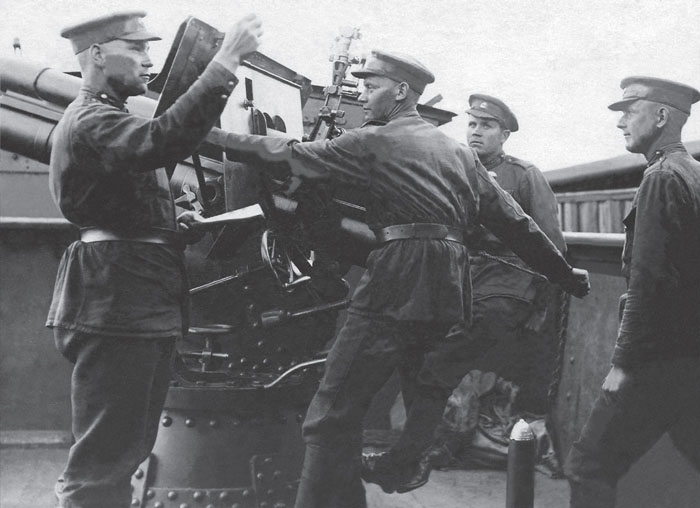
Gunners on artillery wagon ‘Vanapagan’ around their 76.2mm Russian field gun.
(Photos: Paul Malmassari Collection)
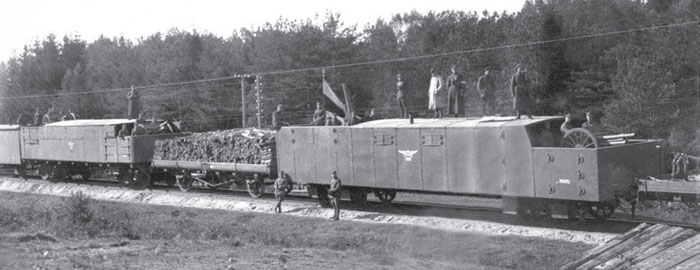
The leading wagon on this train photographed in 1925 is No 302 ‘Maru’, here armed with a 76.2mm Russian field gun on the right, and a 3in(75mm) HA gun on the left. Note the Estonian flag.
(Photo: Paul Malmassari Collection)
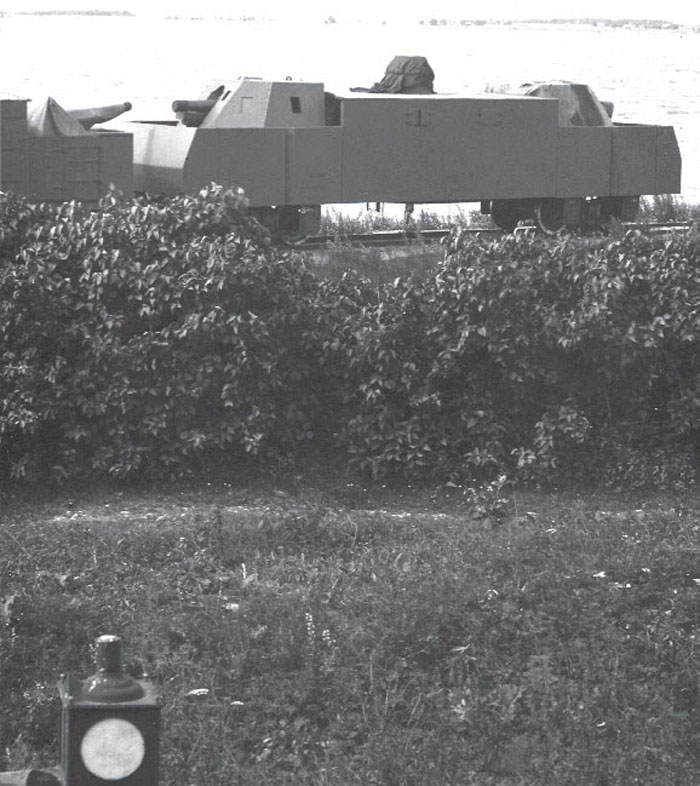
Wagon ‘Tommi’ as modernised in 1929, with two 152mm M1910 Schneider howitzers.
(Photo: Paul Malmassari Collection)
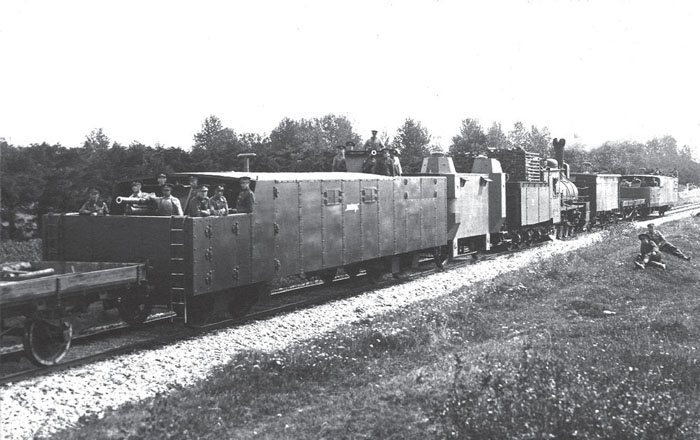
Armoured wagon No 303 ‘Võitleja’ armed with two 76.2mm field guns.
(Photo: Paul Malmassari Collection)
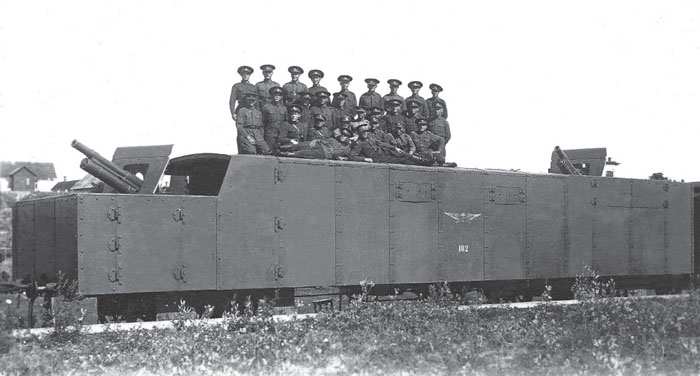
Armoured wagon No 102 ‘Wapper’, built to the same design.
(Photo: Paul Malmassari Collection)
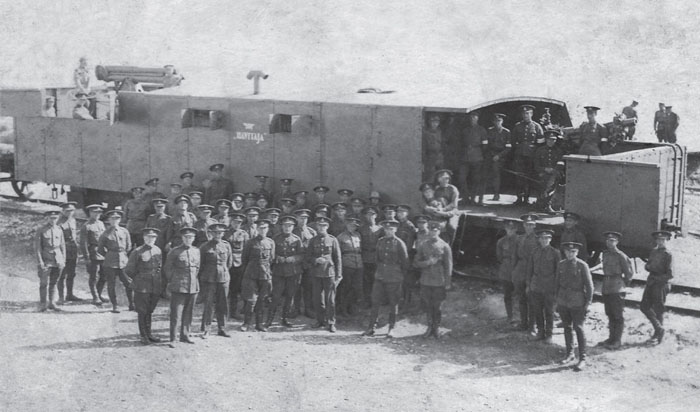
Artillery wagon No 2 ‘Hävitaja’.
(Photo: Paul Malmassari Collection)
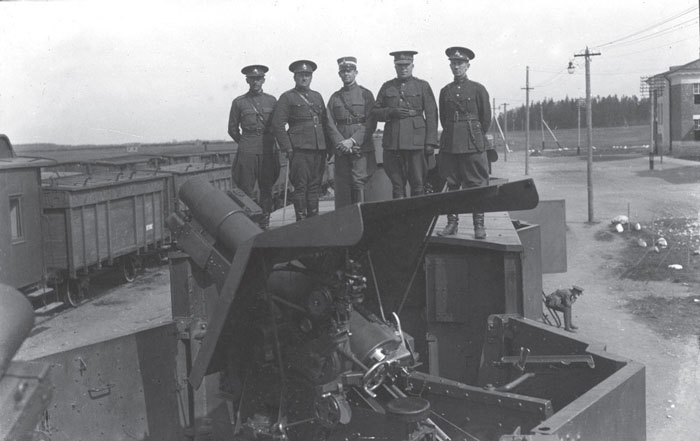
During the modernisation of the armoured wagons in the 1930s, ‘Onu Tom’ and ‘Lembit’ were rearmed with two Vickers 6in (152mm) 26 cwt BL howitzers. Serving these pieces required that the extending side armour walls be jointed to provide continuous protection. Note the presence of a Latvian officer with his Estonian colleagues.
(Photo: Tiit Noormets Collection)
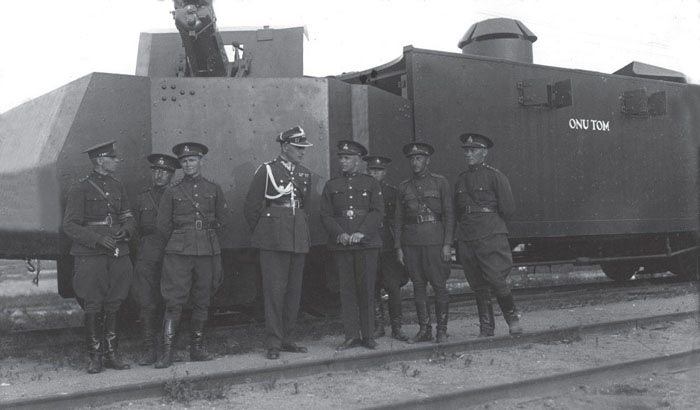
In this photo of the same wagon, note the observation cupola with its four semi-conical sections which hinge open at the top to expose the lookout slots, a design which it seems was unique to Estonia.
(Photo: Tiit Noormets Collection)
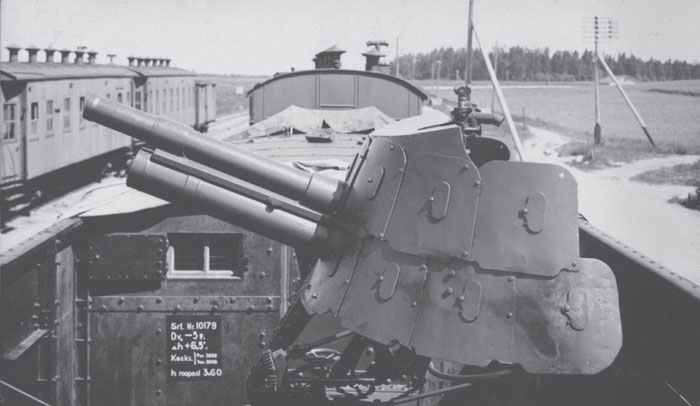
An experimental armoured shield for a 76.2mm gun, using Russian trench shields bolted together. These trench shields were also used to protect several narrow-gauge armoured trains.
(Photo: Tiit Noormets Collection)
SOURCES:
Helme, Mehis, Eesti Kitsarööpmelised Raudteed 1896-1996 (Tallinn: self-published, 1996).
Õun, Matti, Noormets, Tiit, and Pihlak, Jaak, Eesti Soomusrongrid ja Soomusronglased 1918-1941 (Tallinn: Sentinel, 2003).
1. In Estonian: Soomusrong, abbreviated to SR.
2. Used with the tender leading.
3. The original narrow-gauge SR No 4 was destroyed in action on 7 April 1919.
4. Captain Irv, the first armoured train commander, in charge of SR No 1, was killed in action on 27 April 1919.
5. Made up of an engine + two combat wagons with a 76.2mm field gun, a 45mm anti-tank gun and nine machine guns + munitions wagon. The railway gun battery had three 130mm coast-defence guns on unarmoured 50-tonne platform wagons.